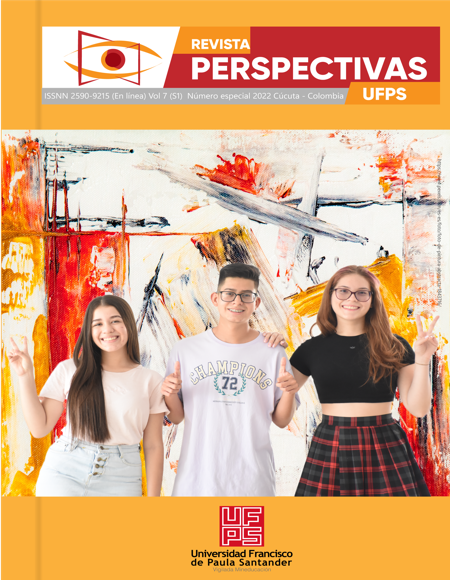Multiple intelligences in students from vulnerable socioeconomic contexts.
Inteligencias múltiples en estudiantes de contextos vulnerables socioeconómicos
Main Article Content
Howard Gardner proposes in his theory of multiple intelligences that intelligence is not confined to a single entity, but is made up of eight interrelated intelligences in each individual, which allows them to face the challenges of their environment more efficiently. However, due to genetic and contextual factors, it is likely that some of these intelligences are more developed than others in each individual. In this context, the question arose as to whether there are differences in multiple intelligences between students from low socioeconomic strata. To answer this question, a cross-sectional, non-experimental, correlational research design with a quantitative approach was used, with a probabilistic multi-stage conglomerate sample made up of 868 students from public schools in the city of Cúcuta, belonging to the fifth grade of basic primary education. The average age of the participants was 11.13 years, with a standard deviation of 1,269 years. The instrument used consisted of two sections: the first collected sociodemographic
information, while the second consisted of questions from the multiple intelligence questionnaire, adapted from McKenzie. Analyzes performed using correlation tests and multiple correspondence analysis yielded significant results. High levels of interpersonal, linguistic and intrapersonal intelligence were observed in the students. In addition, a closeness was found between socioeconomic strata 1 and 2, and low and medium levels of interpersonal intelligence. Socioeconomic stratum 3 showed associations with high levels of linguistic, naturalistic, spatial, and musical intelligence. On the other hand, socioeconomic stratum 4 presented a relationship with average levels of naturalistic intelligence and low average levels of kinesthetic and logical-mathematical intelligence. These findings highlight the possible influence that the socioeconomic context can have on the development and manifestation of multiple intelligences in students
Downloads
Article Details
Arias, F. (2012). El Proyecto de Investigación: Introducción a la Metodología Científica. Caracas: Editorial Episteme
Bennett, M. (1996). Men's and women's selfestimates of intelligence. The Journal of social Psychology, 136(3), 411-412 DOI: https://doi.org/10.1080/00224545.1996.9714021
Bennett, M. (1997). Self-estimates of ability in men and women. The Journal of social Psychology,13 (4), 540-541 DOI: https://doi.org/10.1080/00224549709595475
Congreso de la República de Colombia. (1994, 11 de julio). Ley 142 de 1994. Por la cual se establece el régimen de los servicios públicos domiciliarios y se dictan otras disposiciones. Diario Oficial n°. 41.433. Recuperado de https://www. funcionpublica.gov.co/eva/gestornormativo/ norma.php?i=2752
Chan, D. W. (2001). Assessing giftedness of Chinese secondary students in Hong Kong: A multiple intelligences perspective. High ability Studies, 12 (2), 215-234 DOI: https://doi.org/10.1080/13598130120084348
Chan, D. W. (2006). Perceived multiple intelligences among male and female Chinese gifted students in Hong Kong: The structure of the student multiple intelligences profile. Gifted ChildQuarterly, 50(4), 325-338. DOI: https://doi.org/10.1177/001698620605000405
Departamento Administrativo Nacional de Estadística. (2015). Metodología de estratificación socioeconómica urbana para servicios
públicos domiciliarios. DANE. Recuperado de https://www.dane.gov.co/files/geoestadistica/ estratificacion/EnfoqueConceptual.pdf
García-Botero, L., Aguilar-Barreto, A. J., & Rincón-Álvarez, G. A. (2021). Relación entre las inteligencias múltiples y el género. Mundo
FESC, 11(S6). Recuperado de https://www.fesc.edu.co/Revistas/OJS/index.php/mundofesc/article/view/1125
Gardner, H. (1983). Frame of Mind: The theory of multiple intelligences. New York: Basic Book
International Organization for Migration. (2021). Vulnerability. Retrieved from https://www.iom.int/key-migration-terms#V
Jácome, G., Rodríguez, D., & Medina, P. (2021). Perfil de estudiantes con CHAEA, test de inteligencias y nivel socioeconómico con DOI: https://doi.org/10.55777/rea.v14i28.3649
escalado multidimensional. Revista De Estilos De Aprendizaje, 14(28), 28-45. https://doi. org/10.55777/rea.v14i28.3649
Lord, F. M., & Novick. M. R. (1968). Statistical theories of mental test scores. Reading, Massachusstes: Addison-Wesle
Manota, M. A., & Melendro, M. (2016). Equity and Academic Performance in Colombian Education Education Policy Analysis Archives, 24(81),
-29
McKenzie. W. (1999). Multiples Intelligences and Instructional Technology. Washington: Iste Publications
Rodríguez, R. (2016). Vulnerable groups in Latin American societies. International Journal of Educational Excellence, 2(1), 1-13
Sanchéz, C., Fernández, M. C., Rojo, A., Sainz, M., Hernández, D., Ferrando, M., & Prieto, M. D. (2008). Inteligencias múltiples y superdotación:
percepción de profesores y alumnos. Sobredotaça, 9(2), 87-105
The World Bank. (2021). Poverty Overview. Retrieved from https://www.worldbank.org/en/ topic/poverty
United Nations Children's Fund. (2021). What we do: Child Protection. Retrieved from https:// www.unicef.org/topics/child-protection
United Nations Development Programme. (2021). What is Vulnerability? Retrieved from https:// www.undp.org/lebanon/household-levels/
vulnerability
United Nations Educational, Scientific and Cultural Organization. (2021). Education for Sustainable Development. Retrieved from https://en.unesco. org/themes/education-sustainable-development
United Nations Entity for Gender Equality and the Empowerment of Women. (2021). Gender Equality. Retrieved from https://www.unwomen.
org/en/what-we-do/gender-equality
United Nations Human Settlements Programme. (2021). Housing and Slum Upgrading. Retrievedfrom https://unhabitat.org/topic/housing-andslum-upgrading
United Nations Office for Disaster Risk Reduction). (2021). Understanding Disaster Risk. Retrieved from https://www.undrr.org/terminology/
understanding-disaster-risk
United Nations Population Fund. (2021). Ageing and Older Persons. Retrieved from https://www.unfpa.org/ageing
Vengas, D., Garay, L., & Sillard, A. (2016).Socioeconomic Vulnerability and Academic Performance: A Comparative Study. Journal of
Education and Development, 40(2), 215-230.
Villalta, M. (2010). Socioeconomic Factors and Academic Achievement in Vulnerable Groups. Education Studies, 18(3), 315-328
Villalta, M., & Saavedra, P. (2012). Exploring Academic Performance in Vulnerable Students: A Longitudinal Study. Journal of Educational
Psychology, 28(4), 527-540
World Health Organization. (2021a). Disability. Retrieved from https://www.who.int/healthtopics/disability
World Health Organization. (2021b). Universal Health Coverage (UHC). Retrieved from https:// www.who.int/health-topics/universal-healthcoverage







